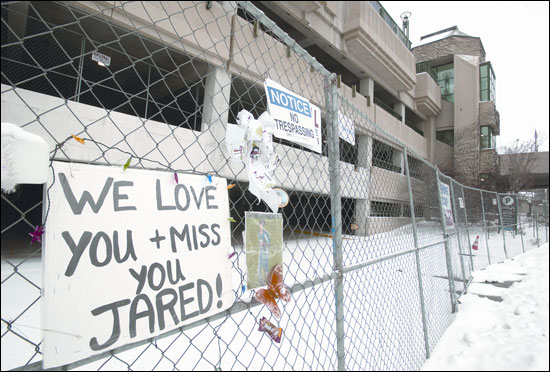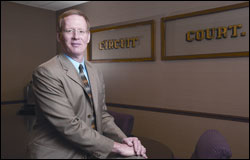Repose the question
By: Jack Zemlicka, [email protected]//January 31, 2011//


Wisconsin’s builders’ statute of repose is known as a lawsuit slayer.
The law, written to insulate contractors, architects and engineers from personal injury claims due to negligent design if an injury occurs 10 years or more after the end of construction, is a major obstacle to overcome in proving liability.
Separate lawsuits stemming from last summer’s fatal incident at the 20-year-old O’Donnell Park parking garage face that daunting task. Lawsuits were filed Jan. 19 on behalf of the estate of Jared Kellner, who was killed, and Amy and Eric Wosinski, who were injured, when a 13½-ton decorative concrete panel fell from the façade of the structure on June 24.
The statute offers protection for “any deficiency or defect in the design, land surveying, planning, supervision or observation of construction of, the construction of, or the furnishing of materials for, the improvement to real property.”
So at first glance, Wis. Stat. 893.89 and case law could block the claims against four companies named as defendants in the Kellner lawsuit.
“I can’t think of a way you would defeat it right now,” said insurance defense attorney John J. Slein of the statute. “I’m sure they will try to plead their way out of it, because it obviously could bar their entire case.”
While he didn’t go so far as to suggest that the suit will be dismissed, Slein couldn’t recall a case where the statute had been trumped.
But the plaintiffs are confident that a statutory exception to the 10-year rule, which has proven successful in other cases, will negate the defense.
The statute contains a provision that bars application for “a person who commits fraud, concealment or misrepresentation related to a deficiency or defect in the improvement to real property.”
William M. Cannon, who is representing Kellner and his family, argued that the defendants knowingly hid defects and cut corners during the construction of the garage, thereby invalidating a statute of repose defense.
“If it was a concealed defect, the statute doesn’t apply,” said Cannon, of Cannon & Dunphy. “Anyone that tells you different doesn’t know what they are talking about.”
Attorney Joshua B. Levy, who is representing defendant Advance Cast Stone, said the exception claim is without merit and the statute of repose is applicable.
While declining to discuss specifics so as not to disclose strategy, the Crivello Carlson attorney said “we believe the work was done correctly and everyone on the project team was aware of the manner in which the work was performed.”
The Kellner suit alleges negligence and also seeks punitive damages against each of the named defendants who finished work on the parking garage in 1991.
Random Lake-based Advance Cast Stone designed, fabricated and installed the decorative concrete panels on the garage’s outer walls; Madison’s J.H. Findorff & Son Inc., managed the construction of the garage; Fond du Lac company C.D. Smith Construction designed and built the parapet walls of the garage; and Dietz Drafting and Design of Burlington did engineering on the project.
While Notice of Injury has been served to both Milwaukee County and the City of Milwaukee, neither has yet been named in the suits. Both entities still have time to respond to the Notice of Injury. If they are named, both would have liability protection under existing law which caps damages at $50,000.
As to how Cannon expects to prove the exception, he said, “come to the depositions and see how.”
Litigation stemming from the 2006 explosion at the Falk Corp. in Milwaukee could serve as a roadmap.
In the suit, attorneys for three workers who died and 15 others injured in the accident alleged that in 1988 a mechanical contracting firm improperly installed an underground propane pipe, which leaked and led to the explosion.

The parties reached a confidential settlement in 2007. Plaintiffs’ attorney Timothy S. Trecek effectively argued that the plans for laying the pipe didn’t match the work that was done, thereby constituting concealment of a defect. After being uncovered, the section of pipe in question was found not to have been placed in a manner dictated by the contract.
Trecek, of Habush Habush & Rottier, said the circumstances of the Falk case are analogous to the O’Donnell Park suits in that the alleged defects are not evident to the naked eye.
Defendants have denied any wrongdoing, but Trecek said if discovery bears out that the panels were improperly installed, the plaintiffs will have solid grounds to prove fraud or misrepresentation.
“It’s a tough argument for the defense to say the contract called for three bolts and only two were there,” he said. “Twelve people on a jury will say people who do that type of work don’t just miss that.”
But it is likely that the defendants will claim that at some point municipal officials signed off on the materials used in construction of the county-owned parking garage, said personal injury attorney Victor C. Harding.
In that case, the argument could be made that the defects were at some point “open and obvious,” which would strengthen the defense that the defects were not concealed.
“If the city had contracts to approve for whatever was produced, I’m sure it will be raised as a defense,” said Harding, of Warshafsky, Rotter, Tarnoff & Bloch.
Attorneys acknowledged that there is little case law dealing with the threshold for what constitutes concealment and misrepresentation under the statute.
Though he disagreed with the decision, Harding said a case which could hinder the O’Donnell suits is the 2006 state Supreme Court decision in Mair v. Trollhaugen Ski Resort, 715 N.W.2d 598.
The case was brought by a woman who tripped and injured herself on a recessed floor drain at the ski lodge in 2001. Because the bathroom had been built 25 years earlier and had never been modified, the court held the ski resort was protected from liability under the statute of repose.
“It’s a bad case that made bad law as far as I’m concerned,” Harding said. “This Kellner case shows why it should be unconstitutional.”
But those involved in the Trollhaugen case suggested that there are differences in the O’Donnell suits which could benefit the plaintiffs.
Michael J. Brose represented Julie Mair and said one of the key distinctions between the two cases is that Trollhaugen simply involved a structural defect which went unchanged over time.
If deterioration contributed to the concrete falling off the garage, he said that would constitute an unsafe condition associated with the structure as opposed to just a structural defect.
“Certainly, the people who made the parking garage did not design it in such a way so that concrete would fall off,” he said. “I think the plaintiffs here are in a better position than my client was.”
Jack Zemlicka can be reached at [email protected].
In an effort to overcome Wisconsin’s builders’ statute of repose law, plaintiffs’ attorneys argue that the defendants hid defects during construction of the project.
Below are the roles played by the defendants and the claims brought by attorneys for Kellner’s family.
Defendants
Advance Cast Stone Co.: installed decorative concrete panels on outer garage walls
J.H. Findorff & Son, Inc.: managed construction of the garage project
C.D. Smith Construction: designed and built the parapet walls of the garage
Dietz Drafting: involved in design and engineering of precast concrete panels
Claim
Defendants concealed and/or misrepresented the deficiencies or defects in the construction of the O’Donnell Park parking garage structure, including, but not limited to the precast architectural panels and the parapet walls to which the panels were attached.
Legal News
- Wisconsin joins Feds, dozens of states to hold airlines accountable for bad behavior
- Trump ahead of Biden in new Marquette poll
- Bankruptcy court approves Milwaukee Marriott Downtown ‘business as usual’ motion
- New Crime Gun Intelligence Center to launch in Chicago
- Arrest warrant proposed for Minocqua Brewing owner who filed Lawsuit against Town of Minocqua
- Wisconsin Supreme Court justices question how much power Legislature should have
- Reinhart named the 2024 Wisconsin law firm of the year by benchmark litigation
- Milwaukee’s Common Council now has the most African Americans, women and openly LGBTQ members ever
- Office of School Safety Provides Behavioral and Threat Assessment Management Training Ahead of 25th Anniversary of Columbine Shooting
- Wisconsin Supreme Court to hear arguments in Democratic governor’s suit against GOP-led Legislature
- Lawsuit asks Wisconsin Supreme Court to strike down governor’s 400-year veto
- Wisconsin man pleads not guilty to neglect in disappearance of boy
WLJ People
- Power 30 Personal Injury Attorneys – Russell Nicolet
- Power 30 Personal Injury Attorneys – Benjamin Nicolet
- Power 30 Personal Injury Attorneys – Dustin T. Woehl
- Power 30 Personal Injury Attorneys – Katherine Metzger
- Power 30 Personal Injury Attorneys – Joseph Ryan
- Power 30 Personal Injury Attorneys – James M. Ryan
- Power 30 Personal Injury Attorneys – Dana Wachs
- Power 30 Personal Injury Attorneys – Mark L. Thomsen
- Power 30 Personal Injury Attorneys – Matthew Lein
- Power 30 Personal Injury Attorneys – Jeffrey A. Pitman
- Power 30 Personal Injury Attorneys – William Pemberton
- Power 30 Personal Injury Attorneys – Howard S. Sicula











